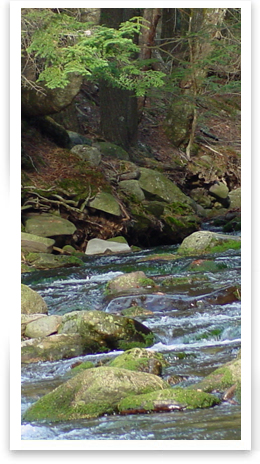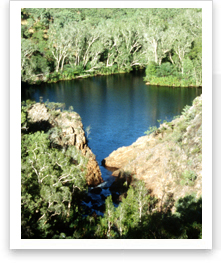Application of the ESS concept for sustainable management of tropical ecosystems
Introduction
The ecosystem services concept has contributed to sustainable NRM in a number of key ways as identified above. However, as a newly emerging and evolving approach much of the potential benefit of this framework for NRM has yet to be widely realised. The following subsections will discuss the major ways the concept of ecosystem services and their valuation has contributed to natural resource management, provide example case studies relevant to the management of tropical rainforests and savanna ecosystems, and discuss further potential applications as identified in the literature.
Development of Markets for Ecosystem Services
One of the main ways proposed to successful incorporate ecosystem services into decision making is to develop markets to value and trade these services.
![]()
Activity 4.4
With reference to the following readings answer these questions:
- Murtough, G., et al. (2002) Creating Markets for Ecosystem Servicesť Productivity Commissions Staff Research Paper, AusInfo, Canberra, Introduction p1-2 Chapter 2 p3-11, Chapter 4 p27-44.
- Robbins, A. (2005) “Ecosystem Services Markets” Centre for Sustainable Forestry at Pack Forest, University of Washington, Seattle, Washington.
Q1 Why do we need to create markets for ecosystem services?
![]()
To include the externality of making use of ecosystem services,
particularly if that use is causing damage, and reward those who
provide ecosystem services that others benefit from.
(Murtough et al. 2002) p3.
Q2 What different types of market creation could be used?
![]()
Refer to table (Murtough et al. 2002) p7.
Q3 List and describe the markets that have been created or proposed for biodiversity, watershed protection and greenhouse gas emissions.
![]()
A3 Refer to chapter 4 (Murtough et al. 2002) and (Robbins 2005) p6-8.
Evaluating Tradeoffs in Development Options and Land-Cover Uses
This application of the ESS concept and valuation of ecosystem services is still in its infancy. Nevertheless, there are examples of this application of ecosystem service valuation, predominantly in temperate ecosystems as well as in research to support the management various ecosystems. The classic example of trade-off analysis is the catchment management for clean water plan developed for Catskill Mountains Catchment, New York.
"Before it became overwhelmed by agriculture ad sewage runoff, the watershed of the Catskill Mountains provided New York with water ranked among the best in the USA. When the water fell below quality standards the City investigated what it would cost to install an water filtration plant compared to the price of improving land management in the catchment. The estimated price tag of a new filtration facility was six to eight billion dollars – a high price to pay for what was once free. The city opted instead to invest a fraction of that amount, $660M in restoring the natural capital of the catchment. In 1997 the city instituted an Environmental Bond Issue and is currently using the funds to purchase land and cease unsustainable development, compensate land owners for development restrictions, and subsidise the improvement of septic systems." (ESA “Ecosystem Services Fact Sheet")
The Catskill Mountains case is an example of the trade-off between protecting an existing but compromised ecosystem services by increasing the health of the ecosystem, or replacing the service with a technological substitute.
In the following activity we will consider another application of trade-off analysis, which accepts that some level of increased intensification and/or expansion of development (e.g. agriculture) is inevitable. However, appropriate location and sustainable design of these activities can ensure that the ability of ecosystems to provide ecological services are maintained whilst the provision of economic services is increased. Recent research into identifying sustainable land-use options for the Del Plata Basin in South America. The Del Plata Basin encompasses southern Brazil, Paraguay, Uruguay and north eastern Argentina.
![]()
Activity 4.5
Read the following article:
- Viglizzo, E.F. & Frank, F.C. (2006) “Land-use Options for the Del Plata Basin in South America: Trade-off Analysis Based on Ecosystem Service Provision” Ecological Economics 57: 140-151.
Note: The research in this article is also based on simulation modelling and provides a lot of detail on the model construction. You are not expected to fully understand the modelling process or the details of its construction (i.e. section 2.5. p.144). We are interested in the application of this model and the general application of models to trade-off alternative land-use options.
Q1 Based on the points made in the abstract what were the authors’ key findings?
![]()
The researchers results demonstrate that the difference in biomes to provide economic as well as ecosystem services in the Del Plata Basin is enormous and that cultivation of new lands in some biomes would neither compensate nor justify the loss of irreplaceable ecosystem services. Not all ecosystems are affected equally by agricultural exploitation. Functional complementation (i.e. the ecosystems ability to function to provide both economic and ecological services) of biomes as determined by trade-off analysis is proposed by Viglizzo and Frank (2006) as a viable broad scale strategy to identify sustainable land-use options in Del Plata Basin.
Q2 Summarise in simple terms (i.e. without quoting model equations) how the authors conducted their evaluation of the value of ecosystem services produced and how they compared the services produced by the different study biomes. (Hint: include the concepts of critical thresholds and the human intervention factor).
![]()
Based on the results of Costanza et al. (1997) the authors analysed the economic and ecological benefits derived from 4 biomes (tropical rainforest, grasslands/rangelands (including savanna), swamps/floodplains and croplands). They considered the relative % conversion of one biome into another and the alteration of economic value due to changes in the provision of ecosystem services. This was done through the identification of trade-offs between economic and ecological values and critical thresholds (refer to the graph on p147). Human intervention factors were calculated to reflect the relative impact of different land-use /land-cover percentage on ecosystem service disruption.
Q3 What were Viglizzo & Frank’s (2006) key findings on the comparative sensitivity of biomes in the Del Plata Basin?
![]()
Answer with reference to (Viglizzo and Frank 2006) p146-148.
Q4 Discuss the limitation and uncertainties of this study.
![]()
Discuss the following points:
- Difficulty of placing a value on ecosystem services
- Discount rate not considered by Costanza et al (1997)
- No markets so price value unavoidably uncertain
- Sources of uncertainty in new methodology proposed
- Ecosystem services values considered for single ecosystem services ignoring possible interactions and interdependencies
- Selected values correspond to average values selected from the literature, i.e. temporal and spatial variability ignored
- Contribution of different ecosystems to ecosystem service provision only well established for one ecosystem in the study Basin
- Determination of a critical threshold may be controversial
Modelling Future Alternative Scenarios
The third major way the ecosystem services concept is applied to inform resource management decisions is to model possible future scenarios based on incremental changes in ecosystems and/or their provision of ecosystem services.
![]()
Activity 4.6
Read the following article:
- Pattanayak, S.K.& Butry, D.T. (2005) “Spatial Complementarity of Forests and Farms: Accounting for Ecosystem Services” American Journal of Agriculture and Economics 87(4):995-1008 (refer to p995-996 and 1003-1008).
Note: The research in this article is also based on simulation modelling and provides a lot of detail on the model construction. You are not expected to fully understand the modelling process or the details of its construction (i.e. p997-end first paragraph p1003). We are interested in the application of this model and the general application of models to test alternative future scenarios of ecosystem service provision. For further background information refer to the book chapter by Pattanayak and Butry provided through e-reserve (Pattanayak and Butry 2003).
Definitions:
- Baseflow is the non-episodic residue streamflow that is left after rain from a recent rainfall has left the hydrological system as either stormflow (runoff) or evapotranspiration. (This is a simplified view of the hydrological cycle but sufficient for this exercise).
- Weak Complement or Weak Complementarity A weak complement is a non-essential input to household consumption that is consumed with (linked to) a non-market environmental good. In this article labour demand is a weak compliment of both baseflow and erosion. Baseflow was found to have a positive and significant effect on labour demand, while erosion was found to have a negative and significant impact.
Q1 What do the authors identify as the key to valuing an incremental change is ecosystem function?
![]()
The key to valuing a change in an ecosystem function is to establish the link between that function and the provision of a service or services valued by people. This can be achieved by producing a simulation model to simulate alternative potential (i.e. realistically possible) changes in ecosystem function and predict the potential change in ecosystem service provision and economic impact.
Q2 The economic value of ecosystem services be viewed as the outcome of what three sets of functional relationships? (p997) Construct a flow diagram to illustrate this concept.
![]()
- Public policies combine with private decisions to affect forested watersheds (catchments) this produces a change in the provision of ecosystem services by these ecosystems.
- This change in ecosystem service provision affects private production activities.
- This change in private production activities has consequences for the economic welfare of private production.
The change in economic welfare can be evaluated in terms of the market prices of private commodities and is the use value of ecosystem services. See diagram.
Q3 What were the scenarios tested?
![]()
A 5% increase in ecosystem services (drought mitigation and erosion control) and a 10% increase in ecosystem services.
Q4 Summarise the authors’ findings on the contribution of the ecosystem services drought mitigation (hydrological flow stabilisation) and soil conservation (erosion control) to the agricultural profits of typical households.
![]()
A4 Refer to p1003 section “Ecosystem Values”.
Next topic - Management of human interactions with tropical ecosystems
Topics in this module
- Introduction
- Management issues & drivers of degradation and deforestaton
- Ecosystem services and sustainable management of tropical ecosystems
- Application of the ESS concept for sustainable management of tropical ecosystems
- Management of human interactions with tropical ecosystems
- Compulsory readings



